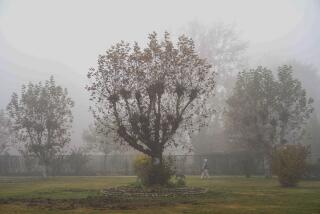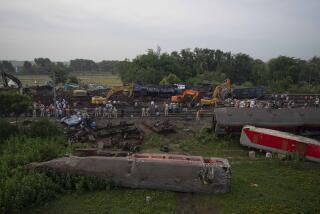Overused, Underdeveloped ‘Highways’ Put India’s Drivers on Road to Ruin
- Share via
NEW DELHI, India — Buses and trucks hurtle along Indian highways like rusting, exhaust-belching embodiments of some angry god of impatience.
They swerve around bicycle rickshaws and ox carts and gaping potholes. They blare their horns at oncoming unfortunates.
After a few miles on the road, the tooting blends into a constant howl. No wonder it’s rare for more than a few days to pass without a report of a horrifying traffic accident from some corner or another of India.
“Every year, about 65,000 people die on Indian roads. This does not inspire confidence in our infrastructure,” Transport Minister T.G. Venkatraman said with striking understatement in a recent speech.
An additional 300,000 people are injured in traffic accidents every year. The Bombay Chamber of Commerce, in a study of roads and traffic, found that while India has only 3.5% of the vehicles in the world, it accounts for 10% of total highway deaths.
Certainly, many of India’s neighbors are as poor or poorer, unable to care for the roads they have or to build sorely needed new ones. And there are governments throughout the developing world that, like India’s, are often accused of being too corrupt and weak to manage their services.
But in India, those common problems are exacerbated by an uncommon one: a population nearing 1 billion. S.P. Singh, a researcher for the Indian Foundation of Transport Research and Training, says India’s narrow roads are among the most crowded in the world.
Even deadlier, he says, is the mix of vehicles in that traffic jam--everything from high-powered luxury cars to overcrowded buses to donkey carts to bicycles jockey for space on the roads. In other countries, the vehicles aren’t as varied, making traffic more predictable and safer.
International comparisons are difficult, because not every country keeps reliable records. The Washington-based International Road Federation counts almost three deaths for every 1,000 vehicles in India, well above industrialized countries like Japan with .15 deaths and the United States with .22. But it’s also much higher than the 1.93 for South Africa, a country with its own reputation for deadly roads.
With many vehicles as dilapidated as the roads they ply, Indian drivers seem frustrated into recklessness. Basic rules like stopping at a flashing red light or yielding to oncoming traffic when attempting to pass are routinely ignored--or simply unknown.
The result is that size and aggressiveness are everything, and the fierce trucks and buses rule.
Some common unsafe practices are a matter of necessity. While a middle-class American family of four can afford a car for a drive across town, an Indian dad pilots a motor scooter with junior propped between his knees and mom riding sidesaddle behind him, baby in her lap.
In Europe, reliable buses run between small towns, a luxury in India where 50 villagers clamber onto a wagon to be towed by tractor to a wedding in a neighboring hamlet.
Traffic reports from the last month show how serious the consequences can be:
* A speeding, overcrowded school bus plunged off a bridge into a river in New Delhi, killing 30 children. Witnesses said the driver, later charged with culpable homicide, was racing another bus across a road slippery with sand.
* A truck crowded with workers skidded and rolled down a hill in northern India, killing 13 people and injuring another 13.
* An army bus skidded into a canal in the Himalayas, killing at least 12 soldiers and injuring 24 more who were heading home for a Hindu holiday.
* And on just a single day, a truck filled with villagers returning from a birthday celebration rammed head-on into a speeding truck, killing 26; a bus toppled into a gorge in the Himalayas, killing 24; and a bus carrying wedding guests plunged into a canal, killing 34.
Venkatraman, the transport minister, said much of the blame lies with unsafe maneuvers by poorly trained drivers. But he could not deny that the state of the country’s roads plays a role.
Business leaders say the consequences don’t end with deaths on the roads, but include the strangling of the country’s economy.
Raj Kumar Pitambar, managing director of Indian automaker Mahindra and Mahindra, said roads are so bad that factories “just can’t meet the shipment dates at Bombay port. Goods just miss the ships.”
C.R. Chohan, a truck driver who has been hauling building supplies for 32 years, says he rarely meets a delivery deadline. He approaches the frustrations with the bravado it takes to make a living on Indian roads.
“My job’s not dangerous,” Chohan says. “Accidents do happen, but we professionals aren’t afraid, because we know how to avoid problems.”
In a survey of 1,000 cargo drivers like Chohan, the Indian Foundation of Transport Research and Training found more than 90% had been in an accident at some point in their careers.
The foundation said the low-paid profession attracts poorly educated Indians who are more likely to get a license by paying 50 rupees--about $1.40--to a forger than taking a driver training course. Sixty percent of the drivers surveyed admitted their licenses were fake or invalid.
Only 2% of the 101,250 miles of state and national highways in India are four-lane and only 34% two-lane, the Bombay Chamber of Commerce study said. The majority--64%--can barely be called a highway at just one lane. Only about half the country’s roads are paved.
Pitambar, the car executive, hopes change will come soon.
“The roads just can’t take anymore,” he said.
More to Read
Sign up for Essential California
The most important California stories and recommendations in your inbox every morning.
You may occasionally receive promotional content from the Los Angeles Times.










